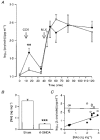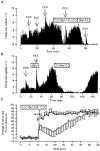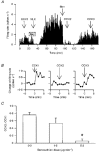Interruption of central noradrenergic pathways and morphine withdrawal excitation of oxytocin neurones in the rat
- PMID: 9508843
- PMCID: PMC2230817
- DOI: 10.1111/j.1469-7793.1998.831bs.x
Interruption of central noradrenergic pathways and morphine withdrawal excitation of oxytocin neurones in the rat
Abstract
1. We have tested the hypothesis that morphine withdrawal excitation of oxytocin neurones that follows from administration of naloxone to morphine-dependent rats is a consequence of excitation of noradrenergic neurones. 2. Female rats were made morphine dependent by intracerebroventricular (i.c.v.) infusion of the opioid at increasing doses over 5 days. On the sixth day, the rats were anaesthetized with urethane or pentobarbitone and prepared for blood sampling to determine plasma oxytocin by radioimmunoassay or for in vivo extracellular recording of the firing rate of identified oxytocin neurones from the supraoptic nucleus. Morphine withdrawal was induced by intravenous (i.v.) injection of the opioid antagonist naloxone (5 mg kg-1). 3. In one group of rats the noradrenergic projections to the hypothalamus were lesioned by i.c.v. injection of 6-hydroxydopamine immediately prior to the induction of morphine dependence. In these rats the oxytocin secretion induced by i.v. cholecystokinin was reduced to 9 % of that seen in sham-lesioned rats but in contrast, no attenuation of morphine withdrawal-induced oxytocin secretion was observed. 4. i.c.v. infusion of the alpha1-adrenoreceptor antagonist benoxathian, at up to 5.3 microg min-1, dose- dependently inhibited the withdrawal excitation of oxytocin neurones in morphine-dependent rats under urethane anaesthesia, and benoxathian reduced withdrawal-induced oxytocin secretion to 37 % of that of vehicle-infused rats. i.c.v. benoxathian also inhibited the activity of oxytocin neurones in morphine-naïve rats. Similarly, microdialysis administration of 2 mM benoxathian directly onto the surface of the supraoptic nucleus reduced the activity of oxytocin neurones by 53 %. 5. Thus noradrenergic systems are not essential for the expression of morphine withdrawal excitation, since chronic neurotoxic destruction of the noradrenergic inputs to the hypothalamus did not affect the magnitude of withdrawal-induced oxytocin secretion. However, tonically active noradrenergic inputs influence the excitability of oxytocin neurones, and acute antagonism of this noradrenergic tone can powerfully impair the ability of oxytocin neurones to exhibit morphine withdrawal excitation.
Figures




Similar articles
-
Activation of oxytocin neurones by systemic cholecystokinin is unchanged by morphine dependence or withdrawal excitation in the rat.J Physiol. 1996 Nov 1;496 ( Pt 3)(Pt 3):787-94. doi: 10.1113/jphysiol.1996.sp021727. J Physiol. 1996. PMID: 8930844 Free PMC article.
-
Oxytocin neurone autoexcitation during morphine withdrawal in anaesthetized rats.Neuroreport. 1997 Mar 3;8(4):951-5. doi: 10.1097/00001756-199703030-00027. Neuroreport. 1997. PMID: 9141071
-
Local opioid inhibition and morphine dependence of supraoptic nucleus oxytocin neurones in the rat in vivo.J Physiol. 1997 Nov 15;505 ( Pt 1)(Pt 1):145-52. doi: 10.1111/j.1469-7793.1997.145bc.x. J Physiol. 1997. PMID: 9409478 Free PMC article.
-
Opioid tolerance and dependence in the magnocellular oxytocin system: a physiological mechanism?Exp Physiol. 1995 May;80(3):307-40. doi: 10.1113/expphysiol.1995.sp003850. Exp Physiol. 1995. PMID: 7640004 Review.
-
Cellular mechanisms underlying neuronal excitability during morphine withdrawal in physical dependence: lessons from the magnocellular oxytocin system.Stress. 2004 Jun;7(2):97-107. doi: 10.1080/10253890410001727776. Stress. 2004. PMID: 15512853 Review.
Cited by
-
Effects of the endogenous opioid peptide, endomorphin 1, on supraoptic nucleus oxytocin and vasopressin neurones in vivo and in vitro.Br J Pharmacol. 2001 Mar;132(5):1136-44. doi: 10.1038/sj.bjp.0703911. Br J Pharmacol. 2001. PMID: 11226145 Free PMC article.
-
Apamin increases post-spike excitability of supraoptic nucleus neurons in anaesthetized morphine-naïve rats and morphine-dependent rats: consequences for morphine withdrawal excitation.Exp Brain Res. 2011 Aug;212(4):517-28. doi: 10.1007/s00221-011-2759-z. Epub 2011 Jun 14. Exp Brain Res. 2011. PMID: 21671103
-
Physiological regulation of magnocellular neurosecretory cell activity: integration of intrinsic, local and afferent mechanisms.J Neuroendocrinol. 2013 Aug;25(8):678-710. doi: 10.1111/jne.12051. J Neuroendocrinol. 2013. PMID: 23701531 Free PMC article. Review.
-
Local morphine withdrawal increases c-fos gene, Fos protein, and oxytocin gene expression in hypothalamic magnocellular neurosecretory cells.J Neurosci. 2000 Feb 1;20(3):1272-80. doi: 10.1523/JNEUROSCI.20-03-01272.2000. J Neurosci. 2000. PMID: 10648731 Free PMC article.
-
Somato-dendritic vasopressin and oxytocin secretion in endocrine and autonomic regulation.J Neuroendocrinol. 2020 Jun;32(6):e12856. doi: 10.1111/jne.12856. Epub 2020 May 14. J Neuroendocrinol. 2020. PMID: 32406599 Free PMC article. Review.
References
-
- Aghajanian GK. Tolerance of locus coeruleus neurones to morphine and suppression of withdrawal response by clonidine. Nature. 1978;276:186–188. - PubMed
-
- Aghajanian GK, Kogan JH, Moghaddam B. Opiate withdrawal increases glutamate and aspartate efflux in the locus coeruleus: an in vivo microdialysis study. Brain Research. 1994;636:126–130. 10.1016/0006-8993(94)90186-4. - DOI - PubMed
-
- Bicknell RJ. Optimizing release from peptide hormone secretory nerve terminals. Journal of Experimental Biology. 1988;139:51–65. - PubMed
Publication types
MeSH terms
Substances
LinkOut - more resources
Full Text Sources
Miscellaneous

